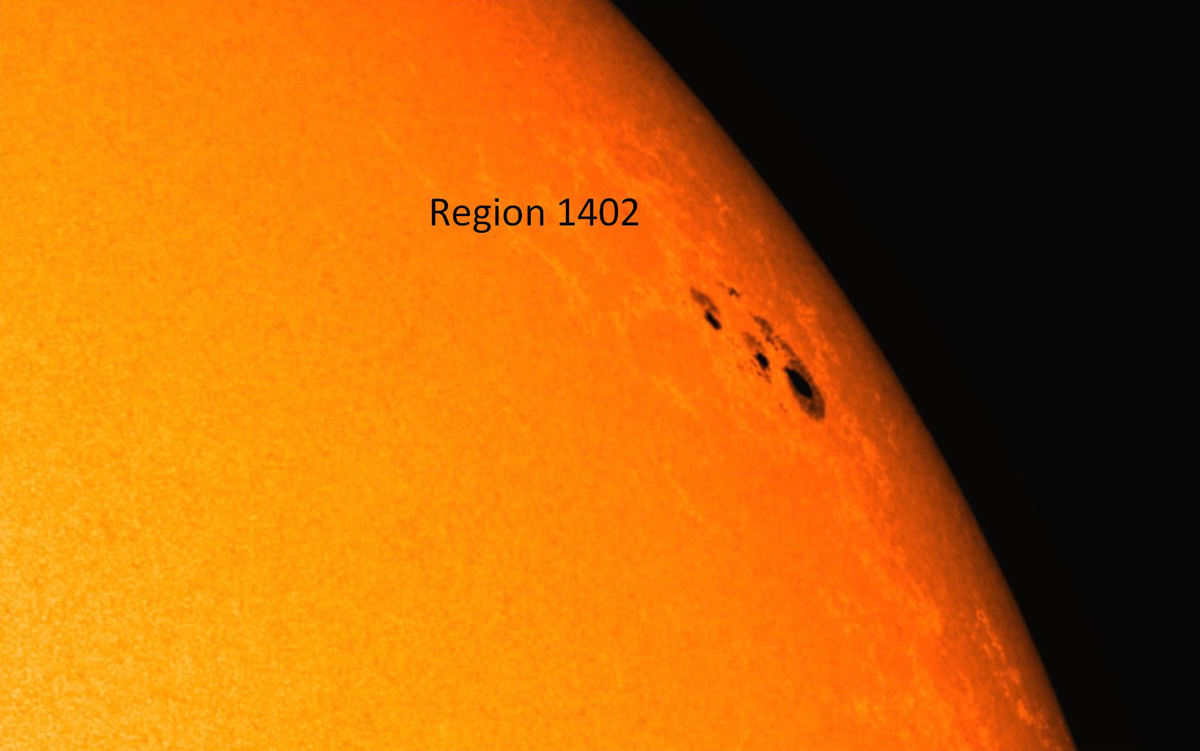Photos: Sunspots on Earth's Closest Star
Sunspot, May 9, 2012
The upper left corner of this image of the sun shows the biggest and most complex sunspot visible on the sun as of May 9, 2012. It has produced 7 M-class flares so far, but has not produced any coronal mass ejections that could cause geomagnetic storms near Earth.
Sunspot AR1476 with Earth Size Comparison
Sunspot AR 1476 compared to the size of Earth. Image released May 10, 2012.
Sunspot AR1476 with Jupiter Size Comparison
Sunspot AR 1476 compared to the size of Jupiter. Image released May 10, 2012.
Monster Sunspot AR1476
The monster sunspot AR1476 (top left) turns into view in this image from NASA's Solar Dynamics Observatory released on May 7, 2012.
Huge Sunspot Complex AR 1476
The monster sunspot group AR 1476 (upper left) measures more than 60,000 miles from end to end. NASA's Solar Dynamics Observatory spacecraft snapped this photo on May 7, 2012.
Sunspot 1302 Already Produced Two X-Class Flares
Sunspot 1302 has already produced two X-flares (X1.4 on Sept. 22nd and X1.9 on Sept. 24th). Each of the dark cores in this image from SDO is larger than Earth, and the entire active region stretches more than 100,000 km from end to end. The sunspot's magnetic field is currently crackling with sub-X-class flares that could grow into larger eruptions as the sunspot continues to turn toward Earth.
Sunspot Complex of Solar Region 1402
Another CME has lifted off Region 1402. Forecasters at NOAA NWS Space Weather Prediction Center are monitoring the energetic particle levels to see if this new CME-flare event, will produce more of these particles. The flare, a C6 x-ray event at 26/0542Z, was a long duration flare (meaning from the flare peak to the flare end was over 30 minutes) and had an associated partial-halo CME. This CME looks to be none Earth directed, but further analysis is being done.
Breaking space news, the latest updates on rocket launches, skywatching events and more!
Largest Sunspot in Years
The gigantic sunspot in the upper left of this image is about 50,000 miles (80,000 km) long and was observed on the sun by NASA's Solar Dynamics Observatory on Nov. 3, 2011.
Sunspot Region 1402
This image from one of the cameras on NASA's Solar Dynamics Observatory shows the sun as it appeared on Jan. 24, 2012. The sunspot grouping in the upper right of the sun's disk is known as Active Region 1402, a sunspot region responsible for recent solar storms. The prominent spot on the left is region 1408.
Hinode's High-Resolution View of the Sun
A new sunspot collided with an existing sunspot which built up a highly sheared magnetic configuration. This resulted in a solar flare on December 13, 2006.
Sun Sputters
A close-up of one active region on the sun, seen in profile in extreme ultraviolet light, produced an interesting display of dynamic and frenetic sputtering over three days (Aug. 28-30, 2011).
Join our Space Forums to keep talking space on the latest missions, night sky and more! And if you have a news tip, correction or comment, let us know at: community@space.com.

Space.com is the premier source of space exploration, innovation and astronomy news, chronicling (and celebrating) humanity's ongoing expansion across the final frontier. Originally founded in 1999, Space.com is, and always has been, the passion of writers and editors who are space fans and also trained journalists. Our current news team consists of Editor-in-Chief Tariq Malik; Editor Hanneke Weitering, Senior Space Writer Mike Wall; Senior Writer Meghan Bartels; Senior Writer Chelsea Gohd, Senior Writer Tereza Pultarova and Staff Writer Alexander Cox, focusing on e-commerce. Senior Producer Steve Spaleta oversees our space videos, with Diana Whitcroft as our Social Media Editor.











